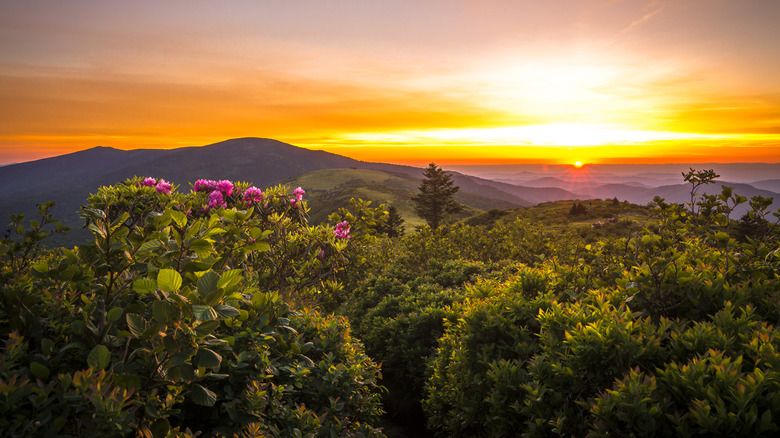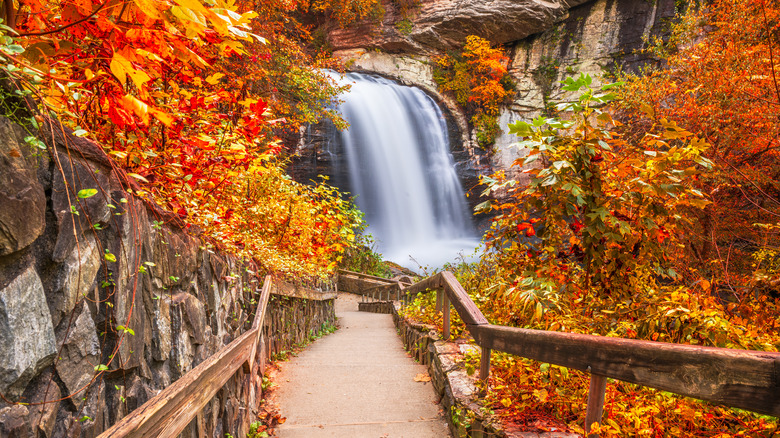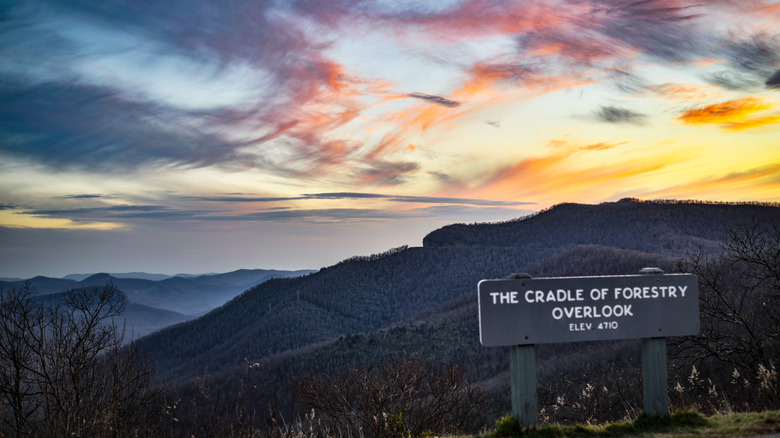This Mountainous Byway May Be North Carolina's Most Underrated Road Trip Route
Home to the iconic Outer Banks, the historic Biltmore Estate, and the hazy peaks of Smoky Mountain National Park, North Carolina is a beautiful destination year-round. As the weather heats up, it's only natural to crave a summertime road trip with the windows rolled down and the speakers on high. With 62 scenic byways scattered across the coastal plains, marshlands, and Appalachian mountains, road-tripping is the perfect way to traverse North Carolina's stunning topography. Blue Ridge Parkway and Mount Mitchell Scenic Drive rest among some of the state's most well-known routes and often overshadow some of North Carolina's underrated (yet just as captivating) scenic drives.
Forest Heritage Scenic Byway weaves drivers through 64 miles of densely forested woodlands, the Blue Ridge Mountains, Pisgah National Forest, and the French Broad River Valley. Glistening waterfalls and abundant wildlife are visible at nearly every turn of this winding road, backed by a stunning canvas of lush, verdant greenery. With nearly two hours of ground to cover, this scenic road trip can be completed in a day or treated as an extension of a longer journey to iconic hot spots like Charlotte or Raleigh.
Travelers can find the starting point for Forest Heritage Scenic Byway just above the town of Brevard at the intersection between U.S. 64, N.C. 280, and U.S. 276, and the finish line near Rosman. Particular points of interest travelers should note include Looking Glass Falls, Lake Logan, The Pink Beds, Brevard, and the Cradle of Forestry.
Brevard to Rosman
With a reputation as one of "America's coolest small towns," Brevard marks the launching platform for the Forest Heritage Scenic Byway. This charming community in Transylvania County houses 250 waterfalls and a flourishing craft brewery scene. Nestled on the edge of Pisgah National Forest, Brevard is the gateway to this town's seemingly endless backyard. Just outside Brevard on U.S. 276, Looking Glass Falls is one of the state's most captivating waterfalls, beloved by travelers for its easy accessibility. Spilling out over the moss-covered cliffs and descending into a deep, rocky pool, visitors can cool off under the mist of the falls.
10 miles up the road from Looking Glass Falls sits the Cradle of Forestry, the designated birthplace of American forestry. This 6,500-acre patch of forest rests right outside Asheville and consists of seven historical buildings constructed by members of the once-active Biltmore Forest School. Paved trails and guided hiking tours create an excellent roadside stopping point to get out and stretch your legs. The perfect complement to the views in this wilderness park, Pink Beds Overlook provides sweeping views of the valley below blanketed in pink blooms during early summer.
Located on the back half of this route, check out Lake Logan — a pristine 80-acre reservoir bordered by pines in the heart of the Smoky Mountains. Situated in Sunburst, North Carolina, this community received its moniker from the striking sunbeams that rise over the lake as dawn slowly covers the land.
Mark your calendars and pack your bags
With a topography as diverse as the state itself, North Carolina boasts a stunning seasonal display evident from summer to winter. From the white flurries that cover the treetops in winter and the vibrant foliage displays in autumn to the warm, colorful months of spring and summer, there's no wrong time to visit this state. Many might consider fall the best time to travel to North Carolina because of the stunning red and orange leaves that dapple the ground. However, planning your road trip during late spring or early summer provides the greatest opportunity to explore the scenic wilderness along this byway with the most favorable weather conditions. With multiple opportunities for hiking and swimming along the way, indulging in a warm-weather road trip is a traveler's best bet. Spring temperatures in western North Carolina tend to peak in the 70s, while summers are warm with average temperatures in the 80s, encouraging visitors to cool off in the region's numerous lakes and waterfalls.
While the Forest Heritage Scenic Byway is undeniably beautiful, American highways must meet certain characteristics before they're defined as an official scenic byway. According to the U.S. Department of Transportation, a scenic byway must meet one or more of six key features, including archeological, cultural, historic, natural, recreational, and scenic. Given the historical landmarks, like the Cradle of Forestry and the naturally picturesque views encompassing the entire route, there's no disputing the highway qualifies as a scenic byway.


